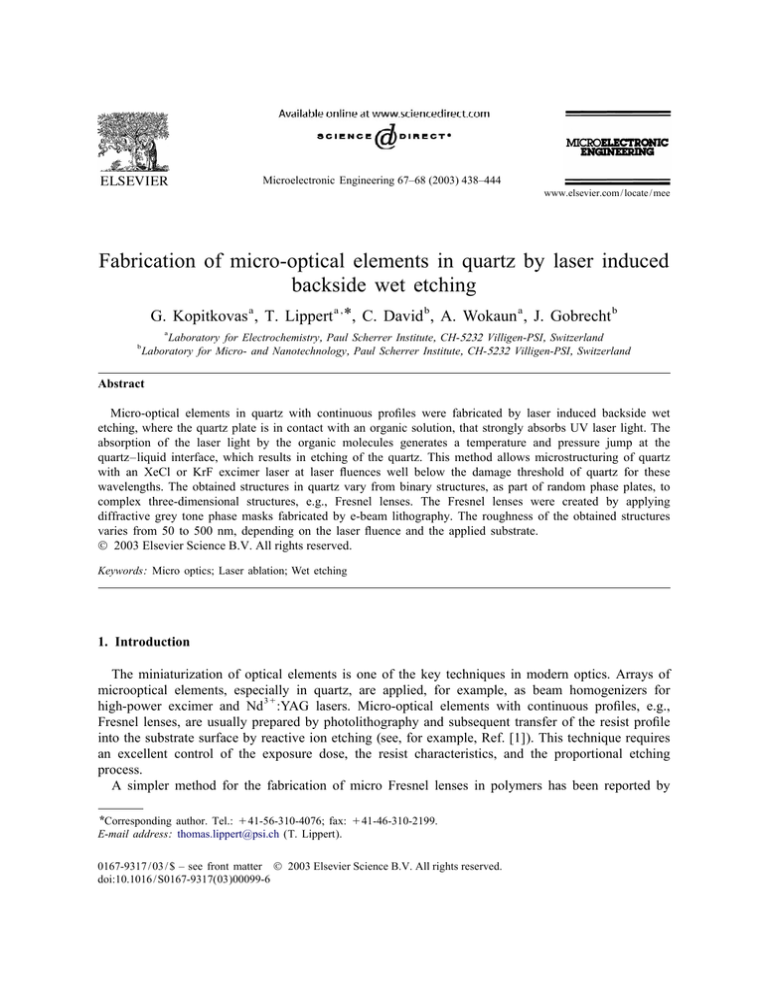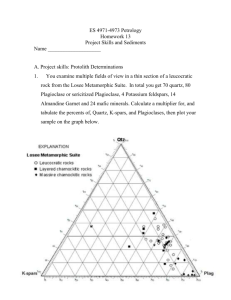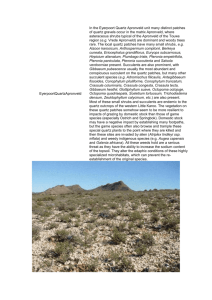
Microelectronic Engineering 67–68 (2003) 438–444
www.elsevier.com / locate / mee
Fabrication of micro-optical elements in quartz by laser induced
backside wet etching
G. Kopitkovas a , T. Lippert a , *, C. David b , A. Wokaun a , J. Gobrecht b
a
b
Laboratory for Electrochemistry, Paul Scherrer Institute, CH-5232 Villigen-PSI, Switzerland
Laboratory for Micro- and Nanotechnology, Paul Scherrer Institute, CH-5232 Villigen-PSI, Switzerland
Abstract
Micro-optical elements in quartz with continuous profiles were fabricated by laser induced backside wet
etching, where the quartz plate is in contact with an organic solution, that strongly absorbs UV laser light. The
absorption of the laser light by the organic molecules generates a temperature and pressure jump at the
quartz–liquid interface, which results in etching of the quartz. This method allows microstructuring of quartz
with an XeCl or KrF excimer laser at laser fluences well below the damage threshold of quartz for these
wavelengths. The obtained structures in quartz vary from binary structures, as part of random phase plates, to
complex three-dimensional structures, e.g., Fresnel lenses. The Fresnel lenses were created by applying
diffractive grey tone phase masks fabricated by e-beam lithography. The roughness of the obtained structures
varies from 50 to 500 nm, depending on the laser fluence and the applied substrate.
2003 Elsevier Science B.V. All rights reserved.
Keywords: Micro optics; Laser ablation; Wet etching
1. Introduction
The miniaturization of optical elements is one of the key techniques in modern optics. Arrays of
microoptical elements, especially in quartz, are applied, for example, as beam homogenizers for
high-power excimer and Nd 31 :YAG lasers. Micro-optical elements with continuous profiles, e.g.,
Fresnel lenses, are usually prepared by photolithography and subsequent transfer of the resist profile
into the substrate surface by reactive ion etching (see, for example, Ref. [1]). This technique requires
an excellent control of the exposure dose, the resist characteristics, and the proportional etching
process.
A simpler method for the fabrication of micro Fresnel lenses in polymers has been reported by
* Corresponding author. Tel.: 141-56-310-4076; fax: 141-46-310-2199.
E-mail address: thomas.lippert@psi.ch (T. Lippert).
0167-9317 / 03 / $ – see front matter 2003 Elsevier Science B.V. All rights reserved.
doi:10.1016 / S0167-9317(03)00099-6
G. Kopitkovas et al. / Microelectronic Engineering 67–68 (2003) 438–444
439
David et al. [2]. Here, a diffractive grey tone phase mask consisting of phase grating structures
designed to scatter a defined fraction of the incoming radiation out of the imaging aperture was
applied to transfer the mask image into the polymer by direct laser ablation. However, quartz glass is
transparent to the common laser wavelength and can only be structured by vacuum UV (VUV) (157
nm) lasers [3,4] or by ultrafast (fs or ps) pulsed lasers [5–7]. The VUV lasers are complicated to use,
as they require vacuum or at least a transparent inert gas for the beam pass and standard quartz optics
have a strong absorption. On the other hand, today’s ultrafast lasers have a low power, so they can
only be used with a small focused beam. As a consequence, complex patterns have to be generated by
slow, sequential scanning.
Niino and co-workers investigated the etching of quartz using various lasers (i.e., excimer and
Nd:YAG) and an organic (e.g., pyrene in acetone) solution, which is in contact with the quartz plate
[8–10]. The organic solution is irradiated through the quartz and the UV photons are strongly
absorbed in a thin liquid layer in contact with the quartz. Excitation and relaxation of the pyrene
generates a temperature jump at the quartz–liquid interface, which results in etching of the quartz.
This technique was named laser induced backside wet etching (LIBWE). Up to now mainly proof of
principle experiments, i.e., hole and line structures prepared in quartz by using LIBWE and applying a
slit mask [8–10] or interference grating projection were reported [11].
The fabrication of complex patterns with continuous profiles, i.e., Fresnel lenses, in quartz by
LIBWE and diffractive grey tone phase masks is presented in this paper.
2. Experimental
A quartz plate with a thickness of 0.5 mm was used as sample. As irradiation sources a KrF (248
nm, FWHM 30 ns, Lambda Physics) and an XeCl (308 nm, FWHM 30 ns, Lambda Physics) excimer
laser were applied. The intensity of the lasers was controlled by an attenuator, consisting of a
dielectrical plate. A solution of pyrene in acetone with a concentration of 0.4 M / l was utilized as
‘‘etchant’’. One side of the quartz plate is in contact with the solution, while irradiation is applied
through the other side as shown in Fig. 1. Diffractive grey tone phase masks, fabricated by e-beam
lithography [2], are utilized to modulate the laser intensity. The mask image is projected onto the
quartz by a lens ( f 5 10 cm) creating structures with a typical size of 0.5 3 0.5 mm 2 . The etching is
carried out with laser fluences from 0.7 to 1.1 J / cm 2 and a variable number of pulses, typically around
Fig. 1. Scheme of the experimental setup for laser induced backside wet etching.
440
G. Kopitkovas et al. / Microelectronic Engineering 67–68 (2003) 438–444
800. The depth profiles of the structures are analyzed with a profilometer and by scanning electron
microscopy (SEM).
3. Results and discussion
The etching of quartz by LIBWE revealed a behaviour similar to the ablation of polymer, where a
threshold fluence of ablation exists. Only with laser fluences above this threshold can ablation be
accomplished. The threshold for quartz using LIBWE was determined experimentally by measuring
the etch rates at various laser fluences (shown in Fig. 2A). The threshold fluence for irradiation at 308
nm is 0.5 J / cm 2 and for 248 nm irradiation is 0.3 J / cm 2 . The obtained threshold values are well
below the damage threshold of quartz, which ranges from 10 to 20 J / cm 2 for 248 nm and 308 nm
irradiation [4]. Above the threshold two linear regimes are observed, as shown in Fig. 2A. At low
fluences (below 500 mJ / cm 2 for 248 nm and 700 mJ / cm 2 for 308 nm) the etch rate only increases
slowly with fluence, while above these values the slopes of the curves are about 2.5-times higher (in
absolute values). At all fluences the etch rate of quartz is larger for 248 nm irradiation than for 308 nm
irradiation. This is due to the different absorption mechanisms in the pyrene molecule at the different
irradiation wavelengths [12,13]. A typical roughness of the etched areas of 50 nm was obtained. The
roughness depends on the quality of material and on the applied laser fluences.
The efficient etching of quartz with etch rates of several nm per pulse is due to the deposition of the
laser energy in a thin pyrene–acetone layer above the quartz surface. The linear absorption coefficient
of pyrene in dilute solution was calculated from absorption spectra, and an optical penetration depth
of 0.7 mm was determined for a pyrene acetone solution (0.4 M / l). This suggests, that the laser
energy is deposited in a layer of less than 1 mm thickness. The laser induced temperature jumps at the
quartz–liquid interface for various laser fluences (shown in Fig. 2B) and irradiation wavelengths were
calculated by a modified model for nonradiative relaxation of organic molecules developed for laser
Fig. 2. (A) Etch rates of quartz versus laser fluence: (s) KrF laser (248 nm), (h) XeCl laser (308 nm). (B) Calculated
temperature at the quartz liquid interface, as a function of the laser fluence: (s) KrF laser (248 nm), (h) XeCl laser (308
nm). The laser energy is absorbed in a layer with a thickness of 0.7 mm.
G. Kopitkovas et al. / Microelectronic Engineering 67–68 (2003) 438–444
441
ablation of polymers [12,13]. The laser induced temperature of the quartz surface in contact with the
liquid is around 1900 K for both threshold fluences (248 and 308 nm). This temperature corresponds
quite well to the melting point of quartz (1880 K). The reason why melting of quartz coincides with
etching is not clear, as ‘‘liquid’’ quartz is not soluble in acetone. One possible explanation can be
derived from the critical temperature T C of acetone which is about 500 K. When the laser induced
temperature in the pyrene–acetone solution exceeds T C , the solution vaporizes and forms bubbles
(cavitations). The fast expanding or collapsing bubbles create a high pressure which interacts with the
surface of the melted quartz and removes the quartz by mechanical forces. This mechanism can
explain the experimental etching results in the low fluence range, while for the high fluence range
another mechanism may be dominant. A likely process for removing the ‘‘softened’’ quartz are
acoustic waves, which may be dominant in the high fluence range. The detailed analysis of the
LIBWE process and the different mechanisms are an ongoing project.
To investigate the spatial resolution of the LIBWE process, a Siemens star in quartz was fabricated
by KrF laser irradiation (248 nm) with a fluence of 0.7 J / cm 2 and 800 pulses (shown in Fig. 3A and
B). The SEM pictures of the Siemens star reveal a clean etching without any pronounced cracking of
the quartz. We were able to resolve structures sizes down to 2 mm by analysing the SEM pictures (Fig.
3). Whether this represents an inherent limitation of the LIBWE process is not clear, as the used
projection optics was not optimised in terms of resolution.
Microstructures in quartz have, as discussed above, important applications in optics. Various
three-dimensional structures such as Fresnel lenses with continuous structure profiles were prepared to
test the potential of LIBWE as a fabrication method. A Fresnel lens etched into quartz with 308 nm
radiation and a fluence of 1.1 J / cm 2 is shown in Fig. 4. The line scan of the Fresnel lens shown in
Fig. 4b reveals a plateau in the centre, which is not etched at all. This is probably due to the fact, that
the fluence through the diffractive grey tone phase mask is below the threshold fluence for the ablation
of quartz in this region. This effect could be avoided by considering the threshold in the design of the
mask. The depth variations of the left and right sides are probably due to the inhomogeneous laser
beam profile. Fig. 5 shows the resulting structure when using the same mask for 248 nm irradiation
(0.7 J / cm 2 and 800 pulses). The SEM picture of the Fresnel lens reveals sharp edges between the
Fig. 3. SEM picture of a Siemens Star etched in quartz by LIBWE using a KrF laser.
442
G. Kopitkovas et al. / Microelectronic Engineering 67–68 (2003) 438–444
Fig. 4. (A) 3D profilometer scan of a Fresnel lens etched in quartz by LIBWE using an XeCl (308 nm) laser. (B) Line scan
of the etch profile, corresponding to the Fresnel lens in (A).
concentric rings. The line scan (shown in Fig. 5B) presents the typical features of a Fresnel lens, i.e., a
parabolic depth profile in the center and triangular structure on the sides (see, for example, Ref. [14]).
No effects of the materials threshold are observed. The reason for this is, that the depth of the
diffractive mask structures was optimised for 308 nm, which results in a considerable transmission of
the ‘‘dark’’ areas of the mask.
Another example for a micro optical device is a random phase plate (RPP) (shown in Fig. 6). The
RPP can be used as a ‘‘beam homogeniser’’ and is a possible alternative to the common microlens
arrays, which are very expensive. A random phase plate [15] is a binary diffractive optic, which
enlarges a focal spot while imposing a smooth spatial profile. The surface of the RPP was randomly
tessellated in a square basic elemental shape. Half of the elements produce a zero phase shift while the
other half produce a p phase shift. The design of the RPP starts with computer generation of the
positions of the basic elements in the substrate, which should be etched to a depth of
d 5 l / [2 ? (n 2 1)], where n is the refractive index of the substrate at the operating wavelength l. The
optimization of the size of the basic patterns corresponds to the effective homogenizing of the
Fig. 5. (A) SEM picture of a Fresnel lens etched in quartz by LIBWE using a KrF (248 nm) laser. (B) Line scan of the etch
profile, corresponding to the Fresnel lens in (A).
G. Kopitkovas et al. / Microelectronic Engineering 67–68 (2003) 438–444
443
Fig. 6. Section of a random phase plate in quartz prepared by LIBWE using an XeCl laser.
incoming beam intensity. Each basic element acts as a diffractive aperture and the resulting focal
profile is the superposition of the diffracted light from all other apertures.
An RPP with a pattern size of 250 mm was prepared in quartz by LIBWE. The etch depth of the
RPP was designed for testing the RPP with the fourth harmonic of the Nd 31 :YAG laser at 266 nm.
The spatial energy distributions within the focal spot without and with RPP was examined by a CCD
system. The results are shown in Fig. 7A and B. Analysis of the experimental results suggests that the
energy distribution close to the focal plane without the RPP has a nearly Gaussian profile, and a spot
size of a 200 mm. The beam size close to the focal plane increases with the RPP in front of the
collecting lens, as shown in Fig. 7B. The flat top spatial energy profile, observed with the RPP shows
clearly a better, more homogenous energy distribution.
Fig. 7. Beam profile of a Nd:YAG laser (fourth harmonic, 266 nm) close to the focal plane without an RPP (A) and with an
RPP (B).
G. Kopitkovas et al. / Microelectronic Engineering 67–68 (2003) 438–444
444
4. Conclusions and outlook
We have shown that laser induced backside wet etching is a suitable technique for the fast
fabrication of microstructures in quartz using a relatively simple setup. Our first results indicate, that
the application of diffractive grey tone masks allows the creation of complex three-dimensional
patterns, e.g., Fresnel lenses.
Another optical element that has been created by LIBWE is a random phase plate suited as a beam
homogenizer for high power excimer and Nd 31 :YAG lasers.
Acknowledgements
The authors would like to thank the technical staff of the Laboratory for Micro- and Nanotechnology for the excellent working conditions and P. Willmott for suggesting the fabrication of the RPP.
References
[1]
[2]
[3]
[4]
[5]
[6]
[7]
[8]
[9]
[10]
[11]
[12]
[13]
[14]
[15]
H.P. Herzig (Ed.), Micro-Optics, Taylor&Francis, London, 1998.
C. David, T. Lippert, J. Wei, A. Wokaun, Microelectron. Eng. 57–58 (2001) 453–460.
J. Ihlemann, B. Wolf-Rottke, Appl. Surf. Sci. 106 (1996) 282–286.
J. Ihlemann, B. Wolf-Rottke, P. Simon, Appl. Phys. A 54 (1992) 363–368.
A. Rosenfeld, M. Lorenz, R. Stoian, D. Aschkenasi, Appl. Phys. A 69 (1999) 373–376.
B.C. Stuart, M.D. Feit, S. Hermann, A.M. Rubenchik, B.W. Shore, M.D. Perry, Phys. Rev. B 49 (1996) 1749–1761.
S. Juodkazis, S. Matsuo, H. Misawa, V. Mizeikis, A. Marcinkevicius, H.B. Sun, Y. Tokuda, M. Takahaschi, T. Yoko, J.
Nishii, Appl. Surf. Sci. 8095 (2002) 1–5.
J. Wang, H. Niino, A. Yabe, Appl. Phys. A 68 (1999) 111–113.
X. Ding, Y. Kawaguchi, H. Niino, A. Yabe, Appl. Phys. A 75 (2002) 641–645.
X. Ding, Y. Yasui, Y. Kawaguchi, H. Niino, A. Yabe, Appl. Phys. A 75 (2002) 437–440.
¨
K. Zimmer, R. Bohme,
A. Braun, B. Rauchenbach, F. Bigl, Appl. Phys. A 74 (2002) 453–456.
H. Fukumura, H. Masuhara, Chem. Phys. Lett. 221 (1994) 373–378.
¨
F. Havermeyer, C. Pruner, R.A. Rupp, D.W. Schubert, E. Kratzig,
Appl. Phys. B 72 (2001) 201–205.
N.F. Borrelli (Ed.), Microoptics Technology, Marcel Dekker, New York, 1999.
C.L.S. Lewis, I. Weaver, L.A. Doyle, G.W. Martin, T. Morrow, D.A. Pepler, C.N. Danson, I.N. Ross, Rev. Sci. Instrum.
70 (1999) 2116–2120.





